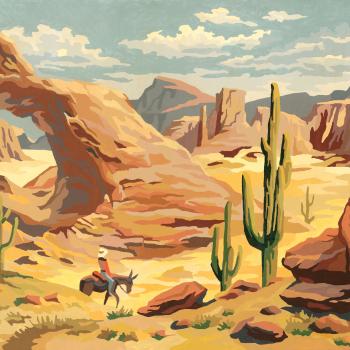"Licensed" to Drive: Old West Figures

- Preview |
- Standards |
- Resources & Preparation |
- Instructional Plan |
- Related Resources |
- Comments
Overview
Students research Old West figures using both electronic and print sources. They then use an online tool to compile and organize reading notes, research, and related ideas. The information that is gathered is then presented in a student-constructed driver's license that includes who, what, when, where, and why they are important in United States history. This activity offers an alternative to the traditional research paper as well as an opportunity for students to share their projects with their classmates.
Featured Resources
- Old West License Project Guide: This resource is used to help guide students through the creation of their driver's license for their Old West Figure.
- Old West License Rubric: This rubric is used for guidance for and assessment of the Old West License Project.
From Theory to Practice
Traditionally, students end a unit of study by writing a research paper. While this is a good way for students to summarize what they have learned, it may not be the most interesting. Beyond that, it frequently results in summarization and rote repetition rather than deep critical thinking. In this lesson plan, students go through the research process, but will take that information and turn it into a driver’s license. This allows students to express their knowledge in a different way. In English Journal, Miriam Karis Cronin says, “Interdisciplinary assignments readily provide students with ways to access new ideas through the use of a variety of learning styles.” This project will allow your students to prove their knowledge in a different and creative way.
Further Reading
Common Core Standards
This resource has been aligned to the Common Core State Standards for states in which they have been adopted. If a state does not appear in the drop-down, CCSS alignments are forthcoming.
State Standards
This lesson has been aligned to standards in the following states. If a state does not appear in the drop-down, standard alignments are not currently available for that state.
NCTE/IRA National Standards for the English Language Arts
- 1. Students read a wide range of print and nonprint texts to build an understanding of texts, of themselves, and of the cultures of the United States and the world; to acquire new information; to respond to the needs and demands of society and the workplace; and for personal fulfillment. Among these texts are fiction and nonfiction, classic and contemporary works.
- 3. Students apply a wide range of strategies to comprehend, interpret, evaluate, and appreciate texts. They draw on their prior experience, their interactions with other readers and writers, their knowledge of word meaning and of other texts, their word identification strategies, and their understanding of textual features (e.g., sound-letter correspondence, sentence structure, context, graphics).
- 5. Students employ a wide range of strategies as they write and use different writing process elements appropriately to communicate with different audiences for a variety of purposes.
- 6. Students apply knowledge of language structure, language conventions (e.g., spelling and punctuation), media techniques, figurative language, and genre to create, critique, and discuss print and nonprint texts.
- 7. Students conduct research on issues and interests by generating ideas and questions, and by posing problems. They gather, evaluate, and synthesize data from a variety of sources (e.g., print and nonprint texts, artifacts, people) to communicate their discoveries in ways that suit their purpose and audience.
- 8. Students use a variety of technological and information resources (e.g., libraries, databases, computer networks, video) to gather and synthesize information and to create and communicate knowledge.
- 9. Students develop an understanding of and respect for diversity in language use, patterns, and dialects across cultures, ethnic groups, geographic regions, and social roles.
- 11. Students participate as knowledgeable, reflective, creative, and critical members of a variety of literacy communities.
- 12. Students use spoken, written, and visual language to accomplish their own purposes (e.g., for learning, enjoyment, persuasion, and the exchange of information).
Materials and Technology
- Art materials for license making, such as construction paper, glue, markers, etc.
- Computer access for research (optional)
- Notebook, binder, or loose paper for notetaking
Printouts
Websites
This PBS website offers a list of links to short biographies on notable western figures. This is great place to start because the articles are short and contain the most important information about the characters.
This is a subscription database that useful articles on figures during western expansion. The reading level is appropriate for middle schoolers and students are allowed to use the images in their projects.
This is a safe search engine that allows the user to do people and biography searches.
This website is useful because it categorizes the figures into their importance making it easier for the students to find what type of person they are interested in. This site also has its own search sites.
Preparation
- Gather copies of books or print sources that the class could use for their Old West Figures. Be sure to review the sources to ensure that they are appropriate for the students use. Please see the Old West Resource List.
- Check the provided Websites to ensure that all are appropriate for students' use.
- Make copies of all handouts students will need: Old West License Project Guide, Old West License Rubric, Old West Peer Review, Old West Figure List.
- Gather art materials for the project (construction paper, glue, markers, etc.).
Student Objectives
Students will:
- demonstrate ability to conduct research using Internet resources and print resources.
- design a driver’s license that exhibits important information about their research topics.
- create a driver’s license that incorporates research skills and text details.
Session One
- Begin the lesson by discussing Western Expansion and the Old West. Have the students share what they know about the topics. If desired, this discussion could be organized using a K-W-L Chart or K-W-L Creator. Please see the Old West Information Handout for basic information the students may need to know. Below are some sample discussion questions.
- Have you ever seen any movies or television shows about Western Expansion?
- Do you know any famous outlaws, lawmen, or Native Americans in western history?
- Why did people move out west?
- What do you know about Calamity Jane, Buffalo Bill, Annie Oakley, Wyatt Earp, or Doc Holliday?
- Distribute or show the students the Old West License Project Guide.
- Discuss with the students the objectives and expectations of the project. Share the rubric with the class.
- Discuss with the students how they are going to achieve their goals using research, peer review, and creativity.
- Discuss with the students the different resources that are going to be used, including both print and Internet sources.
- Facilitate a short discussion about plagiarism. Brainstorm what is considered plagiarism and define the concept for them. (Plagiarism is using others' ideas or words without clearly acknowledging the source of that information.) If this concept is new to your students, consider using the RWT lesson plan Research Building Blocks: “Cite Those Sources!.
- To ensure students are aware of proper citation procedures, reinforce that awareness by:
- providing them with a group of resources to create a bibliography for frequent practice in an activity or learning-center situation. Creating a Bibliography for Your Report discusses the various components of a bibliography. Citation Machine helps students to properly credit the information that they use.
- modeling the step-by-step development of a bibliography for your class in a variety of settings and subject areas.
- posting the standard bibliography format in a prominent place in your classroom.
- Distribute or display your list of Old West Figures to the students.
- Display a variety of print resources. Have the students look through sources to find figures that they are interested in. Refer the students to the Old West Resources.
Session Two
- When all students have selected figures, invite the students to find print materials on their character and use the provided websites to begin researching.
- Instruct the students to take notes in a classroom notebook or binder. Encourage students to keep track of where they are getting their information at all times, because citations will be required.
- As students are researching, walk around and answer questions. Help students as needed.
Session Three
- Explain that once all students have completed their research, they will now construct their final License Project using their notes.
- Display and explain the License Project examples.
- Have the students refer back to the Old West License Project Guide and Old West License Rubric. Answer any clarifying questions that students have before they begin.
- Be sure to have art materials available (construction paper, glue, markers, etc.) for students to use.
- Assist students and answer questions as they work on their licenses.
Session Four
- Students will continue to work on their final license project.
- Once all of the students have completed their licenses, use an example project and peer review it with the class. Be sure to discuss your expectations.
- Pair the students up and have them begin the peer review process.
- Have the students use the Old West License Peer Review, Old West License Project Guide, and Rubric to review each other’s work.
- Have students revise and edit work and orally present their finished products to the class. Have the students focus on the “5 Ws” when they present.
- Display the finished projects on a bulletin board or any visible area.
Extensions
- Have the students write a biographical essay about their Old West figure. The Essay Map can help the students write their essay.
- Instead of making a driver’s license about their figure, students could create a trading card highlighting the importance of an Old West figure. Students can use the RWT Character Trading Card tool.
- Create a driver’s license for a different time period in world or American history.
Student Assessment / Reflections
- For formal assessment, use the rubric to make sure that all requirements have been met. Focus on the quality of the information and the visual appeal of the project.
- Assess the student’s success with their peer review partner using the Peer Review Reflection Form.
- Informal assessment can come from observation, interviews, and examination of the students’ notes and peer review.

Add new comment